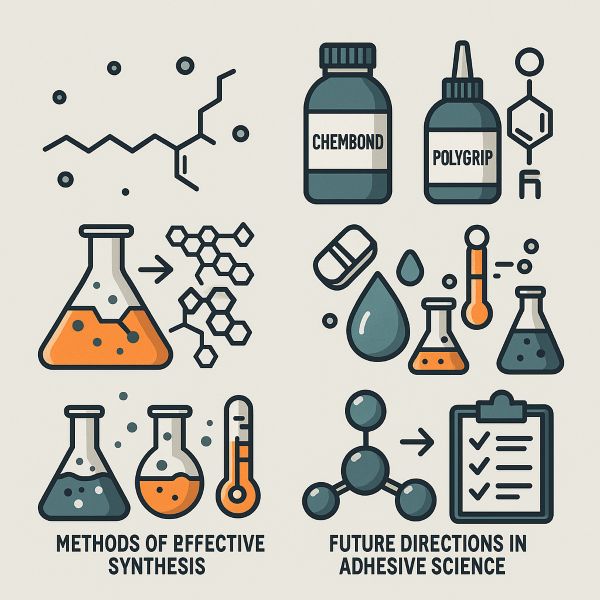
Fatty Acids: Definition and Properties
Polyamide Adhesives: Key Types
Importance of Fatty Acid Synthesis
Methods of Polyamide Adhesive Synthesis
Current Trends in Adhesive Technology
Strategies for Effective Synthesis
Future Directions in Adhesive Science
Frequently Asked Questions (FAQ)
Fatty acids are essential organic compounds composed of long hydrocarbon chains with a carboxyl group. In adhesive technology, these molecules serve as foundational materials for synthesizing polyamide adhesives. Their inherent flexibility, chemical reactivity, and ability to form durable bonds contribute significantly to the development of adhesives with enhanced mechanical strength, heat resistance, and elasticity. The integration of fatty acids into adhesive systems enables improved performance in various industrial applications, including automotive components, textile bonding, and electronics assembly.
Polyamide adhesives are primarily categorized into hot melt and solvent-based formulations. Hot melt polyamides are thermoplastic systems that solidify quickly upon cooling, making them ideal for high-speed manufacturing processes. They are valued for their fast setting times, minimal odor, and clean application. Solvent-based polyamide adhesives, on the other hand, offer excellent durability and chemical resistance, providing robust performance in harsh conditions. These types are used widely in flexible packaging, industrial filters, and automotive assembly, where strong adhesion to varied substrates is essential.
The synthesis of fatty acids is a critical step in developing high-performance polyamide adhesives. By modifying the carbon chain length, saturation level, and branching structure of fatty acids, formulators can tailor the properties of polyamides—such as melt point, flexibility, and compatibility with substrates. This level of customization ensures adhesives meet specific requirements, such as long open time, enhanced tack, or superior heat resistance. As demand grows for versatile, eco-conscious adhesives, the ability to engineer fatty acids for precise performance becomes even more vital.
The most common methods for synthesizing polyamide adhesives involve the polymerization of dicarboxylic acids (or their derivatives) with diamines or fatty acids. Two prominent processes include:
Melt Polycondensation: This thermal method allows for control over molecular weight and viscosity, making it suitable for tailoring adhesive flow and setting characteristics.
Interfacial Polymerization: Conducted at the interface of immiscible liquids, this method produces polyamides with controlled morphology and faster reaction kinetics.
These approaches result in adhesives optimized for specific industrial demands—such as thermal endurance, bond flexibility, or environmental resistance.
Recent developments in adhesive technology reflect a growing interest in sustainable materials and high-performance formulations. Key trends include:
Bio-based polyamides derived from renewable fatty acids
Low-VOC hot melt systems to comply with environmental regulations
Enhanced thermal stability for applications in electronics and automotive sectors
Eco-efficient production techniques, such as solvent-free synthesis
These innovations are paving the way for safer, cleaner, and more effective adhesive products across global industries.
To produce high-quality polyamide adhesives, manufacturers must adopt precise and controlled synthesis strategies. Key factors include:
Accurate temperature control during polymerization to achieve targeted molecular weight
Time optimization to prevent premature crosslinking or degradation
Raw material purity, which directly affects adhesive performance and stability
Selection of catalyst systems to accelerate reaction rates without compromising quality
By refining these processes, producers can develop adhesives that consistently deliver superior bonding across various applications.
The future of polyamide adhesive technology lies in innovation driven by environmental, mechanical, and digital demands. Emerging focus areas include:
Bio-based feedstocks from algae, seed oils, or industrial byproducts
Smart adhesives that respond to heat, pressure, or pH changes
Nano-reinforced polyamides for enhanced mechanical properties and wear resistance
Closed-loop recycling systems to improve sustainability across the adhesive lifecycle
As industries prioritize circular economy goals, the next generation of polyamide adhesives will align performance with ecological responsibility.
What are fatty acids and how are they used in adhesives?
Fatty acids are organic molecules used to synthesize polyamide adhesives. Their structure allows for flexibility and strong bonding, enhancing the performance of adhesives in demanding applications.
What types of polyamide adhesives are commonly used?
Hot melt and solvent-based types are widely used. Hot melts offer quick setting and clean application, while solvent-based polyamides provide durable bonds in chemically or thermally challenging environments.
Why is fatty acid synthesis important in adhesive development?
It allows formulators to tailor adhesive properties such as strength, flexibility, and resistance by engineering fatty acid structures used in polyamide production.
What synthesis methods are used for polyamide adhesives?
Common methods include melt polycondensation and interfacial polymerization, both of which offer precise control over adhesive properties and molecular structure.
What trends are shaping adhesive technology?
Trends include sustainable synthesis methods, bio-based raw materials, high-temperature stability, and the development of low-emission adhesive systems.
How can the synthesis of polyamide adhesives be optimized?
Strategies include precise control over temperature, timing, material selection, and use of efficient catalysts to ensure high performance and consistent quality.
What innovations are expected in future adhesive products?
Expect developments in biodegradable adhesives, smart bonding materials that respond to stimuli, and nano-enhanced systems with advanced mechanical characteristics.
How are polyamide adhesives aligned with environmental goals?
Through renewable sourcing, solvent-free manufacturing, and enhanced durability that reduces waste and extends product life.